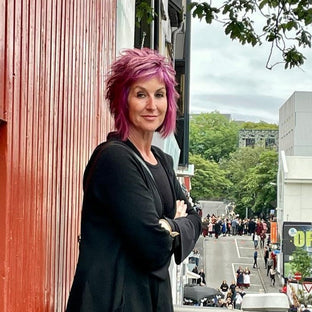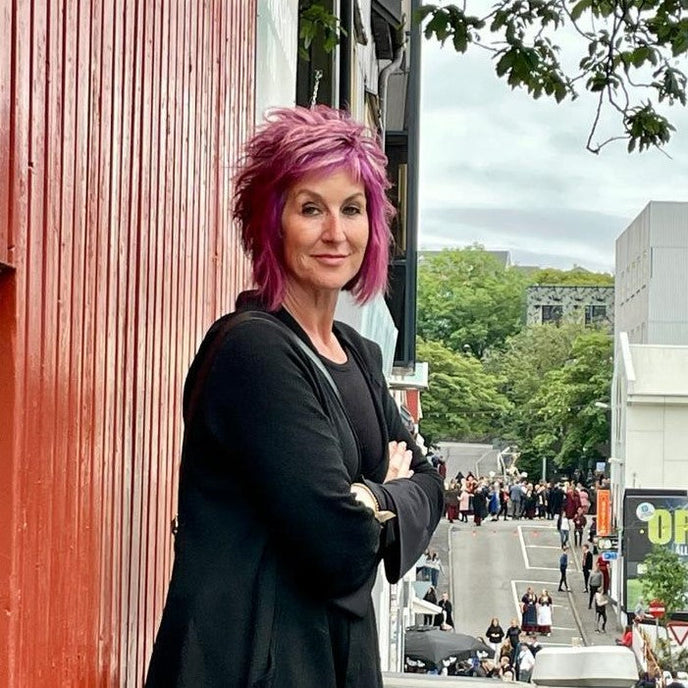A Creative Interview With Artist Janet Hamilton



"People are often surprised by the physicality of the work—how sculptural the surfaces are. The textures don't always translate in photographs, so viewers are frequently taken aback when they see the work in person."
Artist Janet Hamilton creates abstract compositions that reflect the emotional depth of her passion-filled process. She demonstrates a mastery over color choice, with each palette evoking specific moods and emotions. Janet’s ideas come to fruition in her home studio. She has shown her artwork in several exhibitions and featured in many private establishments throughout the United States. When not making art, Janet spends time with her two loving children.
In this interview, Janet shares her routine and the inspirations behind her work.
Please tell us about yourself. What's your home life like? What are your special interests?
I'm an American abstract artist based in Nashville, TN, with over 25 years of experience working in heavily textured, mixed-media landscapes and geometric compositions. I earned my bachelor's degree from Columbia College Chicago, where I first discovered my passion for painting. After college, I worked in the fashion industry and spent time traveling throughout Europe—experiences that continue to influence and inspire my work.
Since becoming a full-time artist in 2011, I've dedicated myself fully to my studio practice. My work has been exhibited in numerous shows and held in private collections across the United States. Outside the studio, I find inspiration and balance through gardening, Pilates, and exploring new places.
Do you have any studio rituals that help you get into a creative flow?
I start with a strong cup of coffee and some music that suits my mood—it helps me settle in and focus. I don't overthink the beginning too much. I just start working and let the materials guide me. Over time, I've learned that getting into the flow isn't about waiting for the perfect moment—it's about showing up, getting my hands moving, and trusting that the energy will come once I'm in it.

How do you structure your day?
I usually start the day with a workout or Pilates to reset my energy, then head into the studio. I keep those early hours clear so I can really dive into the work without distraction. Afternoons are a bit more flexible. Sometimes, I'm still painting, and at other times, I'm catching up on administrative work, such as emails, planning, or preparing for shows. Evenings can also be a good time for creative work, especially when I want to revisit something with fresh eyes. I spend as much time in the studio as I can, and I structure the rest of my day to support that.
Where do you find inspiration for your art?
I find inspiration everywhere—through texture, light, color, and rhythm in the world around me. I'm constantly observing and mentally recording impressions. I also return to my own work often, asking how I can build on or shift what I've done before. I have a running list of ideas and directions I want to explore—more than I could ever finish in one lifetime. That's what keeps the work alive.
Tell us about your evolution as an artist.
My journey began in my early twenties when I moved from a small town in Ohio to Chicago. While studying at Columbia College, I visited the Art Institute of Chicago and was deeply moved by an exhibit of Abstract Expressionism. That moment was a turning point—I felt something click, and I knew I had to paint. I spent my last $200 on art supplies and began experimenting. I've painted nearly every day since. Since 2011, I've worked as a full-time artist, and the studio remains the core of my life. I continue to grow, explore, and take risks with each new piece.
How do you decide when an artwork is finished?
Knowing when to stop is a skill that develops with experience. When I feel a piece might be done, I step away from it to refresh my perspective. If I return to it and nothing stands out as unresolved—if it feels complete both visually and emotionally—then I know it's finished. Over time, I've learned to trust that intuitive sense of closure.
What is the most interesting observation someone has made about your work?
People are often surprised by the physicality of the work—how sculptural the surfaces are. The textures don't always translate in photographs, so viewers are frequently taken aback when they see the work in person. That tactile quality is a big part of what I explore in my process.
Is there an artwork from another artist that has had a significant impact on you?
One artist whose work has had a significant impact on me is Gerhard Richter, especially his abstract pieces. It was a colorful abstract with red, yellow, and green that stopped me in my tracks. I'm fascinated by how he builds depth through layers of color, texture, and movement. His ability to create a sense of spontaneity while still maintaining control really resonates with my own process. Like him, I use multiple layers and various materials to build texture and rhythm in my work. Seeing how Richter allows color and texture to carry so much emotion has continually inspired me to push the boundaries in my own paintings.
What's your favorite museum?
It's hard to pick a favorite because every museum offers something unique. But a few exhibitions stand out as particularly impactful besides Gerhard Richter at the Art Institute, Louise Bourgeois at the Tate in 2007, the David Bowie show at the Museum of Contemporary Art Chicago in 2014, and a remarkable Picasso exhibit in Milan in 2001. Each one left a deep impression—whether through emotional weight, conceptual depth, or pure visual power. I'm especially drawn to museums that allow room for risk, curiosity, and emotional connection.
Is there anything else you'd like to share to help viewers better understand your work?
My work is very much about the process — the layering, the texture, and the energy that comes through building each piece over time. I'm drawn to how color interacts and shifts as layers develop and how texture can create a sense of rhythm and depth. While my paintings may appear abstract, many are rooted in landscapes or geometric forms, reimagined through intuition and spontaneity. I hope viewers can feel the emotion and movement behind the layers — the balance between control and unpredictability — and find their own connection within the work.
Discover more artist features on UGallery
If you enjoyed this article about Janet Hamilton's life and artwork, we recommend reading about Heather Patterson's wood sculptures and Lisa Carney's abstract paintings.







